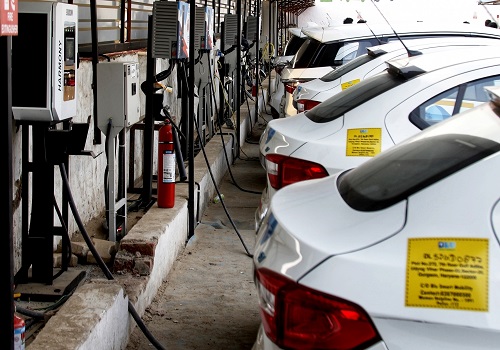Gold trading range for the day is 61960-62710 - Kedia Advisory

Gold
Gold closed lower by -0.24% at 62294 as investors reevaluated monetary policy prospects following economic data and comments from bankers. The US Consumer Price Index (CPI) data, with a 0.2% month-over-month increase in December, slightly below the initial estimate, and the expected 0.3% rise in the core CPI, confirmed a gradual cooldown in price pressures. China's central bank slowed its gold purchases at the beginning of the year, but it remains on track to potentially exceed its last significant buying spree nearly eight years ago. The World Gold Council (WGC) reported that China has increased its official gold reserves for the 15th consecutive month, albeit at a pace half the average since the central bank initiated its buying spree in November 2022. Total gold holdings have risen to 2,245 tonnes, almost 300 tonnes higher than at the end of October 2022. In India, physical gold dealers charged premiums for the first time in four months, responding to increased purchases as local prices eased. The approaching Lunar New Year festival has also boosted gold activity in China and other regions. Dealers charged premiums of up to $2 an ounce over official domestic prices, a change from last week's $4 discounts, reflecting a pickup in demand. Technically, the market is undergoing long liquidation, with open interest dropping by -1.88% to settle at 13692. Despite a significant decline of -149 rupees in prices, Gold is finding support at 62125, with a potential test of 61960 levels if this support is breached. Resistance is anticipated at 62500, and a move above could lead to testing levels around 62710.
Trading Ideas:
* Gold trading range for the day is 61960-62710.
* Gold dropped as investors continued to reassess the monetary policy prospects.
* US CPI increased 0.2% month-over-month in December, while the core CPI went up by expected 0.3%,
* China's central bank buys 10 tonnes of gold, extending its buying spree to 15 straight months
Silver
Silver concluded the session lower by -0.09% at 70774 as optimism around potential Fed rate reductions faded. This shift in sentiment followed statements from Federal Reserve Chairman Jerome Powell and other policymakers, emphasizing that the path of monetary easing would be gradual and unlikely to commence in March. The revised government data showed that U.S. monthly consumer prices rose less than initially estimated in December, with the consumer price index increasing by 0.2% instead of the reported 0.3%. Federal Reserve Bank of Richmond President Thomas Barkin highlighted that the central bank has time to decide its next steps in monetary policy while waiting for further assurance that inflation is falling back to the target. Boston Federal Reserve Bank President Susan Collins expressed the belief that the U.S. central bank would likely cut interest rates by three-quarters of a percentage point this year, contingent on confirming inflation is on a path to 2% amid a strong labor market. The latest report from the Silver Institute projected global silver demand to reach 1.2 billion ounces in 2024, the second-highest level on record, driven by industrial offtake. Technically, the market is undergoing long liquidation, with open interest dropping by -3.81% to settle at 29292. Despite a significant decline of -63 rupees in prices, Silver is finding support at 70410, with a potential test of 70040 levels if this support is breached. Resistance is anticipated at 71165, and a move above could lead to testing levels around 71550.
Trading Ideas:
* Silver trading range for the day is 70040-71550.
* Silver dropped as optimism around Fed rate reductions faded
* U.S. monthly consumer prices rose less than initially estimated in December
* Fed’s Barkin said the central bank has time to decide what’s next for monetary policy
Crude Oil
Crudeoil registered a gain of 0.86% and settled at 6361, driven by persistent tensions in the Middle East. Israel's rejection of a ceasefire offer from Hamas led to continued deadly air strikes on Gaza, contributing to the rise in oil prices. Additionally, Russia's unexpected increase in crude exports in February, along with drone attacks and technical outages at its refineries, influenced the market. The U.S. Energy Information Administration (EIA) indicated that U.S. crude oil production is projected to reach 13.21 million barrels per day (bpd) in 2024. However, this forecast represents a downward revision of 120,000 bpd from earlier expectations. In December 2023, U.S. crude oil production reached an all-time high of 13.3 million bpd but dropped to 12.6 million bpd in January due to cold weather-related shut-ins, particularly in states like North Dakota. Official data revealed a significant decline in U.S. gasoline inventories by 3.15 million barrels last week, surpassing the forecasted draw of 140,000 barrels. However, U.S. crude stockpiles increased by 5.5 million barrels, exceeding expectations for a 1.895 million barrel build. Technically, the market is undergoing short covering, with a notable drop in open interest by -22.24% to settle at 7858. Despite the rise in prices by 54 rupees, Crudeoil is finding support at 6304, with a potential test of 6246 levels if this support is breached. Resistance is anticipated at 6417, and a move above could lead to testing levels around 6472. Overall, the market reflects the impact of geopolitical tensions and unexpected shifts in oil supply dynamics.
Trading Ideas:
* Crudeoil trading range for the day is 6246-6472.
* Crude oil prices rise due to tensions in the Middle East
* Israeli forces continue air strikes on Gaza, contributing to oil price increase
* Russia exports more crude in Feb after refinery attacks
Natural gas
Natural gas witnessed a substantial decline of -4.59% and settled at 153.8 as increased production, mild winter weather, and recent LNG export plant outages depressed demand. Analysts project potential cutbacks in gas drilling as the gas rig count already fell by 23% in 2023, leaving just 120 rigs in service. The U.S. Energy Information Administration (EIA) reported a withdrawal of just 75 billion cubic feet (bcf) of gas from storage for the week ended Feb 2. Although in line with analysts' forecasts, it contrasts sharply with a decrease of 208 bcf in the same week last year and a five-year average decline of 193 bcf for this time of year. LSEG highlighted that gas output in the U.S. Lower 48 states increased to an average of 105.6 billion cubic feet per day (bcfd) in February from 102.1 bcfd in January. Despite this uptick, it remains below the monthly record high of 106.3 bcfd in December. Meteorologists are projecting warmer-than-normal temperatures in the Lower 48 states through Feb 15, followed by a shift to mostly near-to-below-normal levels from Feb 16-23. Technically, the market is experiencing long liquidation, with open interest dropping by -1.19% to settle at 75185. Despite a decline of -7.4 rupees in prices, Natural gas is finding support at 150.9, with a potential test of 148 levels if this support is breached. Resistance is anticipated at 158.3, and a move above could lead to testing levels around 162.8. Overall, the market reflects the impact of increased production, weather conditions, and LNG export plant outages on natural gas prices, prompting a market under long liquidation.
Trading Ideas:
* Naturalgas trading range for the day is 148-162.8.
* Natural gas dropped as production surged and mild winter weather depressed demand
* EIA said utilities pulled just 75 bcf of gas out of storage during the week ended Feb. 2.
* Gas output in the U.S. Lower 48 states rose to an average of 105.6 bcfd so far in February from 102.1 bcfd in January.
Copper
Copper faced downward pressure in yesterday's trading session, closing lower by -0.35% at 703.75. This decline was attributed to several factors, including the strength of the dollar and pessimistic industrial sentiment in China, the world's top consumer of the metal. The dollar's strength, buoyed by robust labor data in the US and hawkish remarks from Fed Chair Powell, reduced the purchasing power of key importers and increased borrowing costs essential for industrial activities. In China, persistent macroeconomic challenges, as evidenced by the fourth consecutive contraction in the manufacturing sector according to official PMI data for January, contributed to the negative outlook for base metals. Despite the unexpected growth in the Caixin China General Manufacturing PMI, contrasting with official data, factories remained cautious, leading to a decline in the Yangshan copper premium and a significant increase in inventories in major Chinese warehouses. On the global scale, preliminary data from the ICSG indicated a modest 1% increase in world copper mine production over the first 11 months of 2023. However, this uptick in production did not alleviate concerns surrounding demand dynamics and the overall health of the copper market, particularly in the face of ongoing economic uncertainties. From a technical perspective, the copper market is witnessing renewed selling pressure, as evidenced by a 2.94% increase in open interest to settle at 6608, coupled with a price decline of -2.5 rupees. Support levels for copper are identified at 700.7, with potential downside tests at 697.6. Conversely, resistance is anticipated at 707.2, with a potential breakout indicating a move towards 710.6.
Trading Ideas:
* Copper trading range for the day is 697.6-710.6.
* Copper dropped due to strength in the dollar and pessimistic industrial sentiment in China.
* Yangshan copper premium declined as factories refrained from purchasing the metal
* Strong labor data in the US and hawkish remarks from Fed Powell lifted the dollar.
Zinc
The recent downtrend in zinc prices, exemplified by yesterday's 1.07% decrease to settle at 207.6, reflects the ongoing economic and demand slowdown in China, a significant zinc consumer. This decline was further compounded by setbacks in the Russian zinc market, notably the delay in production at the Ozernoye mine due to sanctions and a fire-induced plant damage. Originally slated for production in 2023, the mine now anticipates a start no earlier than the third quarter of 2024, with full capacity ramp-up extended to 2025. Such delays exacerbate concerns over global zinc supply, particularly amidst Nyrstar's suspension of Budel smelting operations in the Netherlands due to high energy costs. Current estimations suggest global zinc supplies hover around 14 million tons for the year. However, market sentiment remains tepid, with a notable lack of concern evident in the discount for cash over three-month zinc contracts on the LME, despite occasional spikes reflecting supply anxieties. This sentiment is mirrored in increased deliveries of zinc to LME-registered warehouses, up nearly 200% since November to 199,125 tons, underscoring prevailing surpluses. Technically, the market exhibits signs of fresh selling, as evidenced by a 5.88% rise in open interest to settle at 5290, coupled with a price decline of -2.25 rupees. Support for zinc is identified at 206.1, with potential downside tests at 204.6 levels. Conversely, resistance is expected at 209.5, with a potential breach indicating a move towards 211.4.
Trading Ideas:
* Zinc trading range for the day is 204.6-211.4.
* Zinc dropped as an economic and demand slowdown in China pressured prices.
* Chinese manufacturing PMI data showed a fourth consecutive contraction in the sector, hampering the prices.
* Caixin China General Manufacturing PMI unexpectedly showed growth in factory activity for the third straight month.
Aluminium
Aluminium prices experienced a marginal decline of -0.2% to settle at 200.5 as traders assessed the lack of significant catalysts and subdued trading activity ahead of a prolonged public holiday in China, a key consumer of the metal. Meanwhile, recent data regarding China's aluminium exports to the European Union revealed a 30% decrease in 2023, attributed to the EU's implementation of the Carbon Border Adjustment Mechanism (CBAM) aimed at curbing pollution from foreign products. China's official PMI data indicated a contraction in factory activity for the fourth consecutive month, though the Caixin China General Manufacturing PMI unexpectedly held steady at 50.8 in January 2024, reflecting three straight months of growth. This contrast highlights differing assessments of China's manufacturing sector's performance and adds uncertainty to the market sentiment. On the demand side, primary aluminium imports surged globally, reaching 1.54 million metric tons in 2023, but fell short of the record set in 2021. However, Japan saw a notable decline in imports, down 26% to 1.03 million metric tons, attributed to sluggish demand in construction and manufacturing industries. From a technical perspective, the aluminium market is witnessing long liquidation, with a decline in open interest by -1.62% alongside a slight decrease in prices. Support levels for aluminium are identified at 199.4 and 198.3, while resistance is expected at 201.3, with a potential upward movement testing 202.1.
Trading Ideas:
* Aluminium trading range for the day is 198.3-202.1.
* Aluminium down as traders gauged the lack of fresh market-moving catalysts
* China's export of aluminium covered by EU carbon tax down 30% in 2023
* Japan's imports of primary aluminium fell 26% to 1.03 million metric tons in 2023
Cotton
Cotton prices showed resilience in yesterday's trading session, settling up by 0.62% at 58680. The positive momentum can be attributed to the latest U.S. cotton balance sheet for the 2023/24 season, which reported lower ending stocks, higher exports, and stable production. The export forecast was raised to 12.3 million bales, reflecting a robust pace of shipments and sales, contributing to reduced ending stocks estimated at 2.8 million bales, representing 20% of total disappearance. Internationally, the cotton market witnessed adjustments in ending stocks and production estimates. World ending stocks decreased by nearly 700,000 bales due to lower beginning stocks and production, while consumption remained steady, albeit with variations across countries. Notably, China's imports saw a significant increase, offsetting reductions in other major importing nations like India, Pakistan, Thailand, and Turkey. The USDA's weekly sales report indicated a surge in net sales and exports for the 2023/2024 season, driven by strong demand from China and Vietnam, with exports consistently exceeding 200,000 bales in recent reports. Additionally, the Cotton Association of India (CAI) maintained estimates for domestic consumption and production for the 2023-24 season, reflecting stability in the Indian cotton market. Reports of declining infestation of pink bollworm in cotton crops across the country also provided a positive outlook for production. In the spot market, prices in Rajkot ended slightly lower at 26826.35 Rupees, reflecting minor fluctuations in local trading. From a technical perspective, the market is experiencing fresh buying, with an increase in open interest by 6.12% and prices up by 360 rupees. Support levels for Cottoncandy are identified at 57980 and 57290, with resistance expected at 59080 and potential further upside testing 59490.
Trading Ideas:
* Cottoncandy trading range for the day is 57290-59490.
* Cotton gains as 2023/24 cotton ending stocks are nearly 700,000 bales lower this month
* USDA weekly sales report a 69% increase in exports from previous week
* CAI estimates domestic consumption for the 2023-24 season to remain flat at 311 lakh bales.
* In Rajkot, a major spot market, the price ended at 26826.35 Rupees dropped by -0.26 percent.
Turmeric
The recent performance of turmeric in the market reflects a nuanced interplay of various factors impacting both supply and demand dynamics. Despite settling down by -1.07% at 15166 on profit booking, turmeric prices had previously gained support from reduced supplies in the spot market, driven by delayed harvesting of the new crop and tighter ending stocks. The anticipation of increased demand due to upcoming festivals had also contributed to buoyant market sentiments. However, the pace of export had slowed down in recent months, adding pressure to the market. Notably, turmeric exports during Apr-Nov 2023 experienced a decline of 1.07% compared to the same period in 2022, with November 2023 witnessing a substantial drop of 30.78% year-on-year. The situation is compounded by regional concerns, such as those arising from PM Modi's Turmeric Board in Telangana, which sparked apprehensions among farmers in Maharashtra regarding the headquarters' location. This has led to expectations of a significant decline in turmeric seeding this year, particularly in key producing regions like Maharashtra, Tamil Nadu, Andhra Pradesh, and Telangana, as farmers reassess their priorities. From a technical perspective, the market is experiencing long liquidation, evidenced by a drop in open interest by -1.56% to settle at 13235. Prices have decreased by -164 rupees, with support levels identified at 14986 and 14804, while resistance is anticipated at 15424, with a potential upward movement testing 15680.
Trading Ideas:
* Turmeric trading range for the day is 14804-15680.
* Turmeric dropped on profit booking after prices gained supported by reduced supplies.
* Delayed harvesting of new crop and tighter ending stocks is likely to keep market sentiments up
* Export has been slow down in recent months and expected to increase in wake of series of festivals ahead.
* In Nizamabad, a major spot market, the price ended at 13879.7 Rupees dropped by -0.45 percent.
Jeera
Jeera, a staple spice in Indian cuisine, saw a modest uptick in prices yesterday, rising by 0.22% as a result of short covering activities. This increase comes after a recent decline in prices attributed to higher production prospects in key cultivating regions like Gujarat and Rajasthan. The current rabi season witnessed a notable surge in jeera acreage, reaching a four-year high, driven by favorable market prices in the previous season. Farmers responded to the record prices by expanding cultivation areas in both Gujarat and Rajasthan, demonstrating a direct correlation between market dynamics and acreage. Despite the increase in cultivation, challenges such as lower water availability and concerns about pests and diseases like fusarium wilt continue to persist, potentially impacting yield and quality. Additionally, global demand for Indian jeera has weakened, with buyers favoring alternative sources like Syria and Turkey due to comparatively higher prices in India. This trend has led to a significant decline in jeera exports during Apr-Nov 2023 compared to the same period in the previous year. Technical analysis indicates a shift towards fresh buying, accompanied by an increase in open interest and a slight price increase. Key support and resistance levels have been identified, suggesting potential price movements in the near term. Support is noted at 27020, with a potential downside target of 26820, while resistance is anticipated at 27350, with a possible upward target of 27480.
Trading Ideas:
* Jeera trading range for the day is 26820-27480.
* Jeera gains on short covering after prices dropped due to higher production prospects
* In Gujarat, Cumin sowing witnessed very strong growth by nearly 103% with 530,030.00 hectares against sown area of 2022
* Stockists are showing interest in buying on recent downfall in prices triggering short covering.
* In Unjha, a major spot market, the price ended at 32840.3 Rupees gained by 0.17 percent.
Views express by all participants are for information & academic purpose only.




















